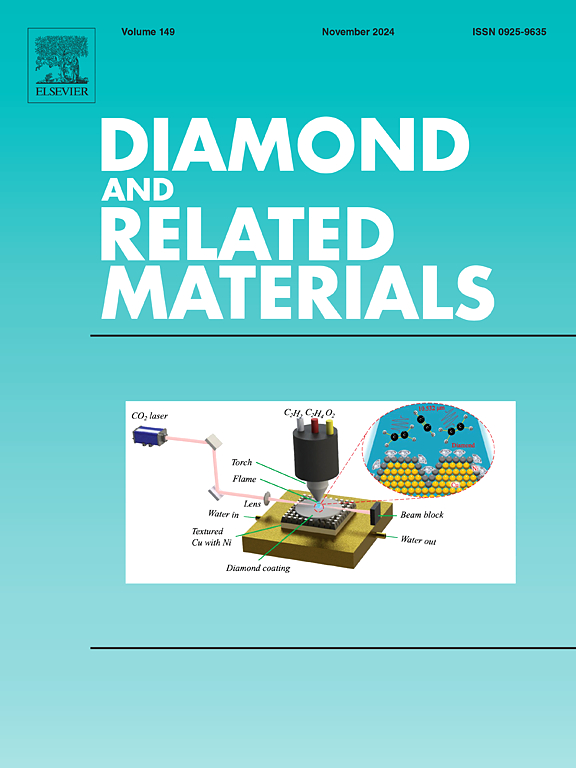石墨烯的沉积结合了类金刚石碳涂层,使用脉冲直流PECVD和额外的阴极用于空间应用
IF 4.3
3区 材料科学
Q2 MATERIALS SCIENCE, COATINGS & FILMS
引用次数: 0
摘要
在本研究中,利用带离子约束装置的脉冲直流PECVD系统,将分散在异丙醇中的石墨烯掺入到沉积在316 L不锈钢衬底上的类金刚石碳(DLC)薄膜中。石墨烯以不同浓度(从0.01到1.0 mg/mL)通过脉冲阀通过玻璃管内部连接进入反应器。采用拉曼光谱分析超声前后的石墨烯,SEM检测表面形貌、粒径分布和石墨烯覆盖率。在常压和高真空条件下对其力学和摩擦学性能进行了评价。拉曼分析表明,随着石墨烯浓度的增加,ID/IG比增加。摩擦系数(COF)随着石墨烯浓度的增加而降低,在常压条件下(0.5 mg/mL石墨烯)达到最小值0.082,在高真空条件下(0.75 mg/mL石墨烯)达到最小值0.011。磨损率在0.75 mg/mL时下降,但在1.0 mg/mL时由于石墨烯的聚集而增加,这促进了裂纹的形成和更高的磨损。真空条件下低COF的磨损机制归因于石墨烯在薄膜表面形成转移层。总体而言,与大气条件相比,dlc -石墨烯薄膜在高真空环境中表现出优越的摩擦学性能。本文章由计算机程序翻译,如有差异,请以英文原文为准。

Deposition of graphene incorporated diamond-like carbon coatings using pulsed-DC PECVD with an additional cathode for space applications
In this study, graphene dispersed in isopropyl alcohol was incorporated into diamond-like carbon (DLC) films deposited on a 316 L stainless steel substrate using a pulsed-DC PECVD system with an ion confinement device. Graphene was introduced into the reactor at various concentrations, from 0.01 to 1.0 mg/mL, via a pulsed valve connected internally through a glass tube. Raman spectroscopy was used to analyze graphene before and after sonication, while SEM was employed to examine surface morphology, particle size distribution, and graphene coverage. Mechanical and tribological properties were evaluated under both atmospheric and high vacuum conditions. Raman analysis indicated an increase in ID/IG ratio as graphene concentration increased. The coefficient of friction (COF) decreased with increasing graphene concentration, reaching a minimum of 0.082 in atmospheric conditions (0.5 mg/mL graphene) and 0.011 in high vacuum (0.75 mg/mL graphene). The wear rate followed a similar trend, decreasing up to 0.75 mg/mL but increasing at 1.0 mg/mL due to graphene agglomeration, which promoted crack formation and higher wear. The wear mechanism for the low COF under vacuum conditions is attributed to graphene forming transfer layers on the surface of the film. Overall, DLC-graphene films exhibited superior tribological performance in a high vacuum environment compared to atmospheric conditions.
求助全文
通过发布文献求助,成功后即可免费获取论文全文。
去求助
来源期刊

Diamond and Related Materials
工程技术-材料科学:综合
CiteScore
6.00
自引率
14.60%
发文量
702
审稿时长
2.1 months
期刊介绍:
DRM is a leading international journal that publishes new fundamental and applied research on all forms of diamond, the integration of diamond with other advanced materials and development of technologies exploiting diamond. The synthesis, characterization and processing of single crystal diamond, polycrystalline films, nanodiamond powders and heterostructures with other advanced materials are encouraged topics for technical and review articles. In addition to diamond, the journal publishes manuscripts on the synthesis, characterization and application of other related materials including diamond-like carbons, carbon nanotubes, graphene, and boron and carbon nitrides. Articles are sought on the chemical functionalization of diamond and related materials as well as their use in electrochemistry, energy storage and conversion, chemical and biological sensing, imaging, thermal management, photonic and quantum applications, electron emission and electronic devices.
The International Conference on Diamond and Carbon Materials has evolved into the largest and most well attended forum in the field of diamond, providing a forum to showcase the latest results in the science and technology of diamond and other carbon materials such as carbon nanotubes, graphene, and diamond-like carbon. Run annually in association with Diamond and Related Materials the conference provides junior and established researchers the opportunity to exchange the latest results ranging from fundamental physical and chemical concepts to applied research focusing on the next generation carbon-based devices.
 求助内容:
求助内容: 应助结果提醒方式:
应助结果提醒方式:


